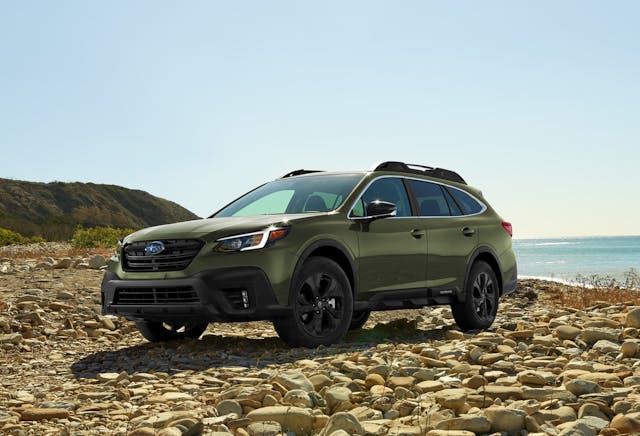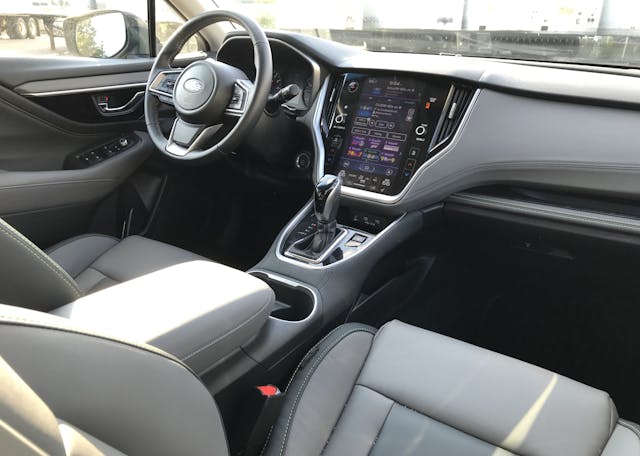Media | Articles
On any new car, a spare tire is a full-sized surprise
It was the end of a long summer beach day. Exhausted by the sun, my wife and son were snoozing away while I was driving toward home in a lengthily-named 2020 Subaru Outback Onyx Edition XT on a four-lane interstate. Suddenly, the low tire pressure dash light illuminated and warning gong, well, gonged at me. The gauge cluster indicated decreasing pressure in the right rear tire. No reason to panic, but rather annoying, if slightly worrying.
The one big concern on my mind: Does the Outback have an actual spare tire?
Small spares, no spares, or inflators
Frustratingly, many new cars today have tire repair kits and/or inflators in lieu of spare tires. Both of those are, of course, worthless if the sidewall of a tire is damaged. Most new vehicles still carry smaller-than-stock temporary spare tires, which are great as long as you are not in the middle of nowhere, in the middle of the night, on a holiday weekend. Then there are the BMWs of the world (a brand that once proudly had a full-size spares in all their cars) which provides little more than a phone number in the trunks in order to reach help from afar.
Having found a secure and well-lit Target parking lot, I started on the tire change. Step one was to see investigate the Outback’s spare tire situation. There was an obvious leak in the (loudly hissing) tire. Once I opened the hatch and ditched the beach stuff, I looked under the cargo cover. Doth my eyes deceive me? I took out the tool kit (!) that was nestled within the spare tire (!!), still in disbelief.
Good Lord, a full-size spare!
It was there in front of me—all I had to do was unbolt it and lift it out of the trunk. After inspecting the the tire size from both sides, I looked at the wheel and even put it next to the deflating one that was on the car, for comparison. Yes, not only was the tire full-sized, it was mounted on a matching wheel. I almost shed a tear.
Marketplace
Buy and sell classics with confidence
The process of replacing the tire was nothing special. With the parking brake on and one wheel chocked with a brick I found, I loosened the lug nuts. I then jacked up the Subi and removed the now flat wheel. Putting the full-size spare on required a bit more jacking. With lug nuts back on, I dropped that bad boy and torqued the lug nuts by feel with the small-ish wrench that most automakers provide in the tool kit. Good enough in a pinch.
An added benefit of having a full-size spare is knowing that the busted wheel that just came off the car will properly fit into the spare tire location. In vehicles with a temporary spare tire, the full-size tire will likely impede the cargo space—not be great when carrying beach chairs and an unnecessarily large cooler.
Exploring the rear suspension
With the wheel removed, I noticed something commonplace but also quite neat about Outback rear suspension. An aluminum upper wishbone control arm connects to a beefy subframe. Subaru says that this sub-frame benefits from the use of high-strength steel and is twice as rigid as that of the previous Outback. The subframe is mounted to the body via thick isolators/spacers, reducing vibrations and giving the Outback that raised look over what would otherwise amount to a Legacy wagon.
Less visible in the above picture are the lower suspension components. Despite Subaru calling it double-wishbone, it is in truth a multi-link setup with three steel links, two of which are sort of aligned to match the upper wishbone. All those suspension components come together at the aluminum wheel hub. On the inner side of this hub, the axle comes in from the subframe mounted differential. On the outer side resides a vented, 11.8-inch brake rotor that is squeezed by a single-piston floating caliper. A sway-bar connects to the subframe and the rear lower control arm via a typical Subaru link.

The new Outback
The sixth generation of the Outback was introduced for the 2020 model year. Subaru did not mess much with the Unofficial Car of Vermont, Colorado, and Other Outdoorsy and Snowy Places (plus dogs). It remains unmistakably similar to the previous generation, but it does hide some significant upgrades. First is the new turbocharged FA24 2.4-liter flat-four engine, originally used in the Ascent three-row SUV and optional on the Outback. Second is an updated interior with an available large center screen.
The turbocharged engine produces 260 horsepower at 5600 rpm and 277 lb-ft between 2000 and 4800 rpm. That is a significant boost over the 182-horsepower and naturally-aspirated 2.5-liter, which itself gets seven extra ponies over the 2019 engine. What seems like a wonderful engine is unfortunately handicapped by a sloppy continuously variable transmission. Like most CVTs, it is a black hole of excitement. Hilariously, there are shift paddles on the wheel that allow the driver to select one of the eight pre-programmed ratios for non-existent gears.
The large, vertically oriented, 11.6-inch infotainment screen allows the use of Apple CarPlay and other audio or climate features at the same time. Handy, but the Apple CarPlay screen is rather small. Further, the Apple CarPlay did not always work well. One time all audio stopped working, even after I unplugged my phone. Even restarting the car did not cure the problem, but it seemed to have magically fixed itself after a good night of sleep.
The Onyx Edition XT model shown here differs slightly from other Outbacks. It builds on the Premium model but rides on specific black 18-inch wheels, has black badging, and specific interior colors and fabrics. Its terrain-selectable traction control system, X-Mode, include additional selections for deep snow and mud. Its all-season Yokohama Avid GT tires are branded the M+S symbol but the thread pattern shows a compromise in favor of a quiet ride. The full-size spare is part of the Onyx Edition model and not available on other models.
Conclusion
Outback faithful need not to worry. The Outback is what it has always been—a tall not-an-SUV station wagon. The integrated, swiveling roof rack crossbars remain, along with great ground clearance, permanent all-wheel drive, and plenty of space. With the newly available engine, it is a little faster, but not much faster, and it can tow a bigger, 3500-pound trailer. Ride is comfortable, steering is mushy. Like our ever-so-humble Site Director expected, “they made it better but not that much better.” Even still, the full-size spare comes highly recommended.

























You say the paddles are hilarious, but you should actually try using them. They’re cleaner and more responsive than non-CVT paddles and function exactly the same otherwise. I’ve never even tried driving either of my subies in regular auto mode.
Cool!!!! Really great info. Thanks my man. Great article 👏 👍🏼